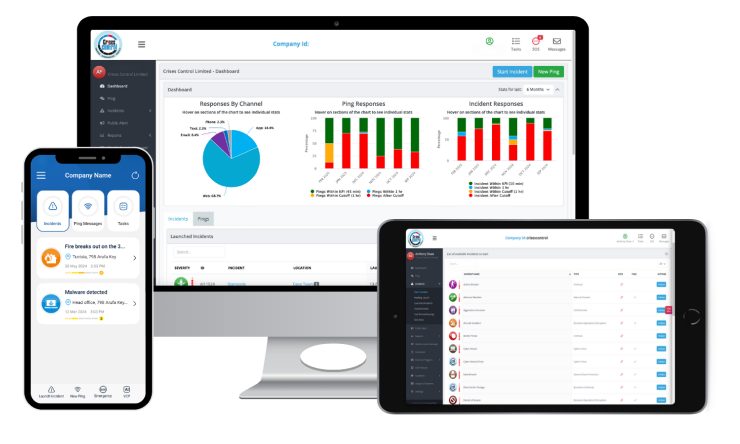Written by Anneri Fourie | Crises Control Executive
Real estate companies manage spaces where people live, work, and spend a significant part of their lives. When emergencies occur, the consequences can be serious. Fires can spread through a building, water leaks can damage multiple units, gas leaks can pose health hazards, and security breaches can put tenants and staff at risk. These situations are unpredictable and can happen at any time. Without a clear plan, property managers can struggle to coordinate responses, communicate effectively, and protect everyone involved.
A Crisis Management Plan provides a structured approach to handling these incidents. It helps property managers act quickly, keep tenants informed, manage emergency services, and comply with regulations. With tools like Crises Control, companies can automate communication, track responses, and ensure everyone stays safe.
What is a Crisis Management Plan for Real Estate?
A Crisis Management Plan for Real Estate is a documented set of procedures outlining how a company responds to emergencies affecting buildings, tenants, and staff. It is more than a checklist. It is a practical guide for coordinating actions under pressure. Key components of a plan include:
- Identifying and classifying potential incidents
- Setting out communication channels and notification processes
- Establishing evacuation and safety procedures
- Coordinating with emergency services
- Meeting regulatory and compliance requirements
Having this framework in place allows property managers to make quick decisions with confidence, reduce risks, and maintain trust with tenants and stakeholders.
Why Do Real Estate Companies Need a Crisis Management Plan?
Buildings can be unpredictable, and real estate companies face a range of hazards that can affect safety, property, and operations.
Fire and Structural Risks
Fires can occur in residential or commercial buildings without warning. Smoke and flames can spread quickly, causing injuries, property damage, and legal exposure. Structural failures, such as collapsing ceilings or walls, are equally dangerous. A Crisis Management Plan ensures that property managers can alert tenants immediately, coordinate evacuations, and contact emergency services without delay.
Flooding and Utility Failures
Flooding from heavy rain, blocked drains, or water main breaks can damage property and disrupt operations. Power outages, elevator malfunctions, or plumbing failures can inconvenience tenants and create operational chaos. Using Mass Notification Software, property managers can notify tenants instantly, coordinate maintenance teams, and provide real-time updates to everyone affected.
Security Threats
Security incidents, including break-ins, armed intruders, or suspicious activity, require fast and accurate communication. Delays in alerting staff and tenants can escalate risks. A crisis plan provides clear protocols for lockdowns, alerts, and real-time tracking of tenants and employees during an emergency.
Regulatory Compliance
Property managers must follow fire safety regulations, occupational health and safety laws, and data protection rules. A crisis plan supported by tools like Crises Control automates reporting, logs compliance actions, and keeps a record of drills and incidents. This reduces administrative work while ensuring tenants and staff remain safe.
How to Prepare a Real Estate Emergency Response Plan
Creating a Crisis Management Plan for Real Estate takes careful planning and input from multiple stakeholders. Here is a practical step-by-step approach.
1. Conduct a Risk Assessment
Start by identifying the types of emergencies that could occur at your properties. Consider minor issues like elevator malfunctions or plumbing leaks, as well as major threats like fires, gas leaks, flooding, or security incidents. Rank each risk by severity and potential impact on tenants, staff, and property.
2. Define Communication Protocols
Clear communication is essential. Ask yourself: How can property managers alert tenants in an emergency? Mass Notification Software for Real Estate can send automated messages through SMS, email, app notifications, and voice calls. This ensures that everyone in the building receives timely instructions.
3. Coordinate with Emergency Services
Prepare contact lists and escalation paths for fire departments, police, medical teams, and utility providers. Make sure your team knows who to contact first in each type of emergency. Establishing relationships ahead of time improves response times and coordination during incidents.
4. Prepare Evacuation and Safety Procedures
Evacuation plans should be clear and practical. Map out escape routes, identify safe zones, and ensure procedures include assistance for tenants with mobility issues. Running drills regularly helps tenants and staff become familiar with the process. Crises Control enables you to log drill participation and monitor effectiveness.
5. Assign Roles and Responsibilities
Define who is responsible for what during an emergency. Assign crisis team members, including points of contact for tenants, staff, and emergency services. Clear responsibilities prevent confusion and help teams act quickly when incidents occur.
6. Monitor, Track, and Update
A crisis plan is not a static document. Regularly review and update it to reflect changes in building layout, regulations, or staffing. Platforms like Crises Control allow real-time monitoring of incidents and centralised logging, making it easier to keep your plan current.
What’s the Best Emergency Communication Tool for Real Estate?
Property managers need tools that combine speed, reach, and compliance. Crises Control’s Ping Mass Notification Software offers:
- Alerts through multiple channels, including SMS, voice, email, and app notifications
- Tenant and staff tracking during emergencies
- Integration with building management and emergency services
- Secure communication that meets GDPR, OSHA, and other regulatory requirements
This makes it possible to send targeted alerts, monitor responses, and keep all stakeholders informed without overloading staff with manual communication tasks.
Real Estate Scenarios Where a Crisis Management Plan Matters
Major Fire in Commercial or Residential Buildings
Rapid alerts save lives and reduce property damage. Using Crises Control, property managers can coordinate evacuation, send instant notifications to tenants and staff, and keep emergency responders updated.
Gas Leaks and Chemical Hazards
Gas leaks or chemical spills are serious health risks. A crisis plan ensures tenants and staff are notified immediately, emergency services are contacted, and evacuation happens safely. Crises Control can handle notifications, track who has been evacuated, and log regulatory reporting.
Flooding or Water Main Breaks
Flooding or water main breaks can affect multiple areas of a property. Automated alerts from Crises Control reduce confusion and help maintenance teams respond faster. Real-time updates to tenants and staff keep everyone informed while repairs are underway.
Security Breaches
Intruders or suspicious activity require quick action. Mass notifications, lockdown instructions, and law enforcement coordination can all be managed through a single platform, helping property managers protect tenants and staff efficiently.
Everyday Preparedness and Drills
Emergencies are easier to handle when tenants and staff are prepared. Routine drills, including fire, evacuation, and security exercises, help everyone understand what to do in a real incident. Crises Control tracks participation, logs results, and highlights areas for improvement. This ongoing practice ensures readiness and builds confidence among staff and tenants.
Benefits of a Crisis Management Plan with Crises Control
Using a crisis management system provides clear advantages:
- Faster response times: Automated alerts and centralised tracking allow quick action.
- Tenant safety: Everyone receives clear instructions during emergencies.
- Regulatory compliance: Logs and automated reports meet local and international requirements.
- Operational continuity: Reduce downtime and maintain building operations during incidents.
- Peace of mind: Property managers can rely on tested procedures and tools in every situation.
With these advantages in place, real estate companies can handle emergencies more confidently, protect tenants and staff, and keep operations running smoothly. A well-implemented Crisis Management Plan supported by Crises Control ensures that when an incident occurs, your team is prepared, informed, and able to act quickly.
Preparing for the Unexpected
Emergencies happen without warning, and preparation can make all the difference. Fires, floods, gas leaks, and security incidents pose serious risks to tenants, staff, and property. A Crisis Management Plan, supported by modern tools like Crises Control, ensures property managers can respond quickly, communicate effectively, and keep everyone safe.
Ask yourself: Do I have a clear plan? Can I alert tenants immediately? Are my staff and emergency contacts ready to act in every scenario? These questions help identify gaps and improve your emergency readiness.
Take Action Today
Real estate companies that invest in a Crisis Management Plan and effective communication tools gain confidence in their ability to handle emergencies. With a plan in place, you can protect tenants, staff, and property while maintaining operational continuity.
Contact Crises Control today for a free demo and discover how our platform can help your team prepare for any emergency.
Request a FREE Demo

